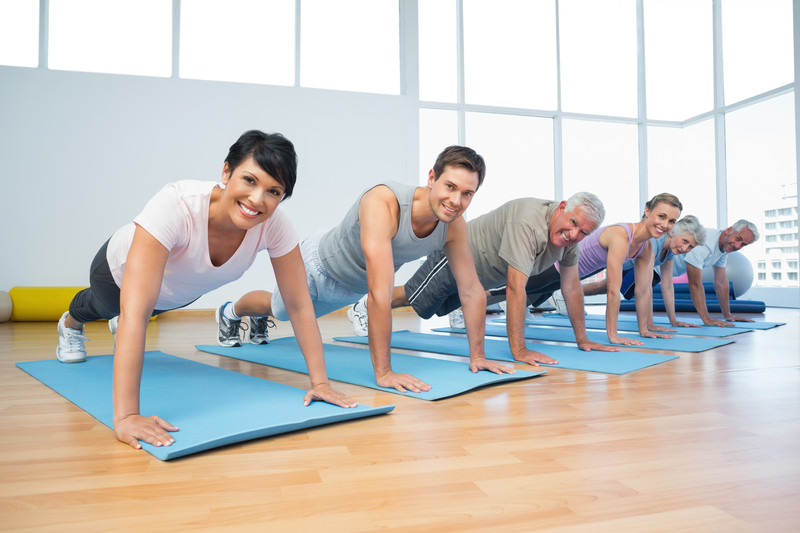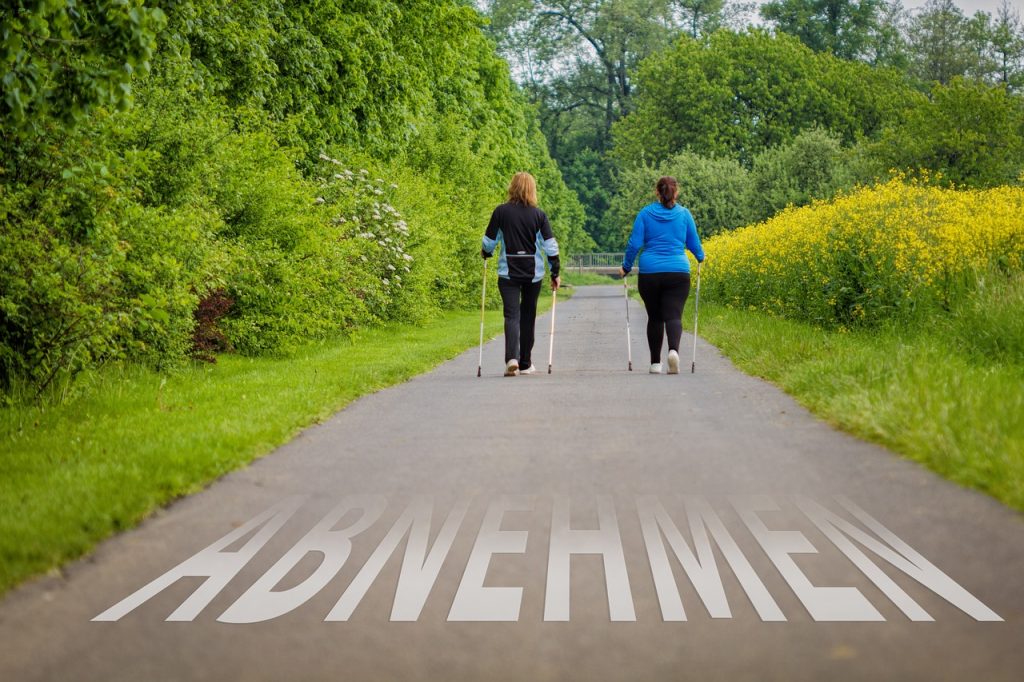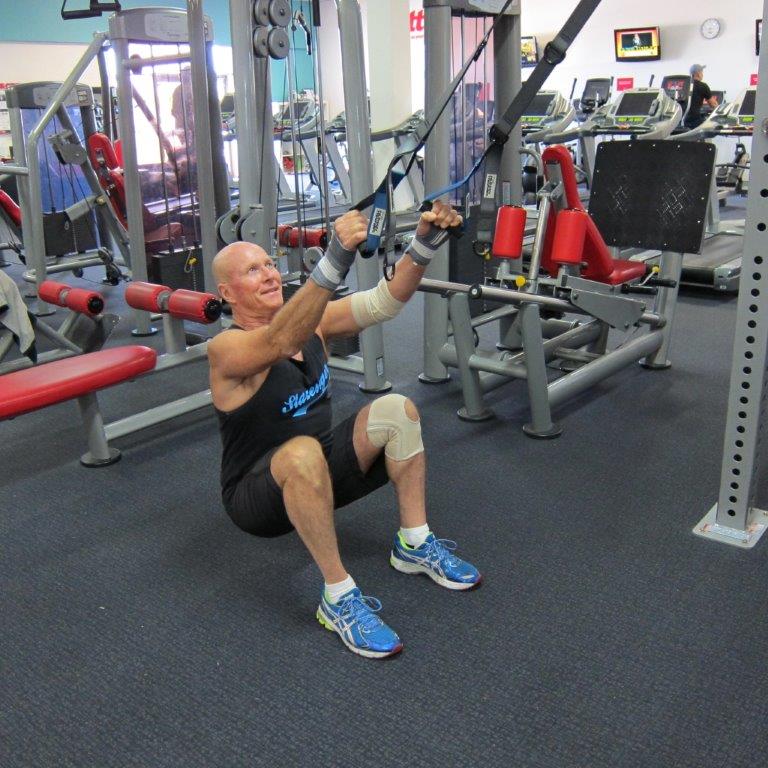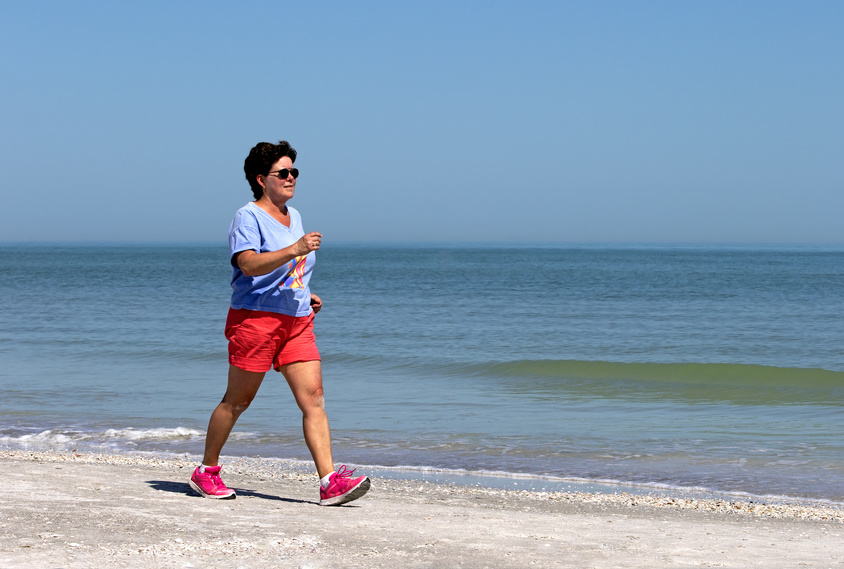…..and the psychological benefits of exercise for older adults is also quite amazing when done on a regular basis.
For many baby boomers I know, the thought of starting a new senior exercise program can be very daunting.
But, whatever your age, I encourage you to come to grips with the proven fact that exercise is one of the healthiest things you can do on a regular basis.
You probably feel depressed or anxious even about moving your body with more exertion than you’re used to especially when your flexibility and mobility could have been compromised over the years from sitting for far too long on one of those posture wrecking office chairs.
What I would like you to understand more than anything, is exercise is like a miracle cure for your lifestyle ailments and has the ability to eliminate those issues – all of them!
In the beginning of your functional fitness program it might wear you out a bit, but that’s only because a lot of boomers tend to overdo it. We are a competitive lot, often to our own detriment.
So take it slow and steady and your energy levels will soar, not diminish. As for any feelings of depression, well exercise is known to release feel good hormones known as endorphins.
You’ll start to feel better, and the chance to exercise also means enhancing your social activity which is great for your brain.
Then there’s anxiety about mobility. You don’t want to start off doing back handstands but by moving around more and strengthening the core of your body will help, not hurt, your mobility.

Core exercises for seniors
Core exercises are at the top of my list when I am starting new clients on an exercise program – it is the most important part of your body when it comes to improving your overall health and fitness and you can see here why I think Core Stability and Core Strength is Imperative for Senior Health.
In fact, there are four areas of fitness for seniors I recommend you work on with your exercise programs. And they are; endurance (cardio), strength training, balance and flexibility exercises.
Let’s look at 6 more of the benefits of exercise for seniors and get a little more in depth about them so you can embrace the idea of developing a fitness routine in your golden years.
1. Exercise is Well Proven to Reverse Many Lifestyle Diseases
While nutrition plays a major role in disease prevention and treatment, moving and strengthening your body does, too. You can feed your fitness levels and literally reverse the damage that diabetes causes, help your cells attack cancer, ward off cardiovascular disease, lower cholesterol and much more.
Heart disease is one of the top killers of both men and women, and when you exercise – regardless of at what age you start – you begin strengthening your heart and giving it the power it needs to keep you healthy.
The movement and exertion you put in during an exercise routine floods your body with oxygen that otherwise may not get circulated.
This helps on a cellular level and enables your immune system and other internal systems to perform at a higher level than a body that is not exercising.
There are sure to be some of you baby boomers reading this who suffers from problems like asthma and you worry about getting involved in an exercise regimen because you already have trouble breathing.
But did you know, exercise can help curb the frequency and severity of an asthma attack? You just have to slowly push your body out of its comfort zone and help it build a tolerance without overdoing it all at once.
2. Exercise Restores Your Youthful Appearance
When it comes to ageing, the majority of the population initially concerns themselves with looks. Before you’re even thinking about flexibility and mobility, you’re more concerned with fine lines around your eyes, hair thinning out and sagging skin.
Exercise is a head to toe solution that can turn back the clock to some degree and help you achieve a youthful glow. It can strengthen your skin and improve your outlook on how you look!
Exercise helps your skin flush out toxins, and when toxins are released, your skin gets more oxygen and has a rosy glow to it. But you have to work up a sweat using cardio or other measures to release toxins.
Did you know there are specific facial exercises you can do to prevent and reverse wrinkles?
They’re called yoga facial exercises, and you can do these easily once a day and help the circulation and boost collagen production to tighten up your skin.
3. Exercise Gets You Out of the House and Keeps Baby Boomers Independent
There are two issues that senior exercise addresses wonderfully – one is getting you active in society, and the other is allowing you to maintain a sense of independence. Many baby boomers begin to rely on others to come to them more and more often.
This keeps you a prisoner in your own home, and it isn’t beneficial to anyone. You can do so many things when you choose to exercise out of your home.
You can join a gym, join a walking, swimming or bike riding group or attend senior exercise classes like Yoga, Pilates or Tai Chi and make some new friends.
There are local shopping centre (mall) walking clubs dedicated to senior citizens. Look online for those, or have someone find one for you. Test it out and see if you enjoy the company of the others in the group.
Many times, these fitness excursions will lead to solid friendships where you’re doing more than just exercise – you’re attending plays, visiting museums, going for coffee or lunch afterwards and much more.
It is well proven that social interaction as you age is very important to both your brain and physical health and fitness.
The independent lifestyle you gain from implementing an exercise regimen is very valuable. You don’t want to have to rely on your kids or friends to take care of you, and by using exercise to strengthen your body, you won’t have to.
Focus on both cardio and strength training for a total body approach to fitness.

The cardio will increase your stamina in terms of your ability to maintain an active lifestyle without tiring out.
The strength training helps you prevent falls and move around with more agility. If you suffer from a condition that affects your mobility, such as painful arthritis, then you’ll be pleased to know that the more you exercise the better your arthritis becomes!
Back pain is another issue that often plagues older adults.
Many people just suffer through it, not wanting to move an inch for fear of experiencing more pain. But did you know that the right kinds of movements will alleviate back pain issues?
Again, core exercises designed for seniors will help prevent back pain, so if nothing else, start with a program that’s built to help strengthen your core. It is the most important part of your body.
Once you have strengthened your core then you can add other exercises to your gym program that allow for more mobility and flexibility.
If you have a mobility issue such as a knee or shoulder joint that’s aching, then you can work on strengthening the muscles around your knee or joint. This will allow you to put more of an impact on your leg over time, helping you get going longer – and farther.
4. Exercise Helps Seniors to Sleep Better
Sleep issues are common as we age. We need less sleep, but for some, the amount of sleep they get is inadequate and you end up fatigued, suffering from brain fog, and in many chronic cases, depressed.
Some people mistakenly believe they have to exercise to the point of exhaustion for fitness to affect sleep. That’s not true. As little as twenty minutes moderate exercise a day can help you sleep better every night.
You don’t want to exercise right before bed, as I have heard some people say they do. That will actually have the opposite effect. Instead, you want to exercise earlier in the day so by the time you’re ready for bed, your body is in a relaxed state – not one where your heart rate is up.
No longer will you lie in bed wondering when you’ll fall asleep. Exercise helps you fall asleep faster. And did you know moderate exercise worked better in studies than vigorous exercise when it came to improving sleep?
You’ll be able to stay asleep after nodding off when you start adding exercise to your daily life. Waking during the night makes it hard for seniors to get any sort of quality sleep time.
You may even sleep a little longer. Instead of 5-6 hours total, you might be able to get a full 7-8 hours of sleep, which will help with so many issues – eliminating fatigue, alleviating irritability, and much more.
5. Fact – Regular Moderate Exercise Improves Your Memory
We all worry about dementia as we age. Did we just forget our keys or is it a sign of something more sinister, like Alzheimer’s? No one wants to think that someday, their memories could be erased.
 Apart from adding muscle mass and toning and reducing unwanted fat deposits, exercise has an important protective role with the brain; it improves neuroplasticity which in turn helps your brain grow and adapt.
Apart from adding muscle mass and toning and reducing unwanted fat deposits, exercise has an important protective role with the brain; it improves neuroplasticity which in turn helps your brain grow and adapt.
Exercise also helps clear out brain fog and keeps your brain tuned up. When you exercise, it literally increases the size of your hippocampus. This is the area of the brain where your verbal and memory learning reside.
The best fitness for brain clarity is cardiovascular, but you still need to do some strength training as well.
With cardio, you need to get it to the point where you’ve worked up a sweat and your heart rate is up to a level where you can just hold a conversation (but with a little bit of difficulty).
Before you do this, have a chat to your doctor and make sure he/she approves.
Further evidence of this being an excellent form of senior fitness is available from Harvard Medical School in this interesting article: Regular exercise changes the brain to improve memory, thinking skills.
When you exercise, there are chemicals that get released in your body. They can affect many parts of your being, but they also improve your brain. They grow new cells and blood vessels, and help older brain cells survive even longer.
We already spoke about sleep and depression. Well when you’re not getting enough rest and your mood is altered by a lack of sleep, it can cause brain fog. Exercise clears it up quickly and easily – and it doesn’t take much to make it happen.
To try out this method of clarity, make it simple. Pick two days of the week and walk for one hour. Or, pick four days and walk for 30 minutes. That’s all you need to achieve more mental clarity through exercise.
Just make sure you walk at a brisk pace. You don’t have to run or jog, but do enough so that you’re working up a sweat and your heart rate is starting to climb in a safe level for you.
The neural connections you’ll be making will keep your mind healthy, just as the physical exercise will also strengthen your body. Consider it as good quality nourishment for your mind and body every time you lace up your shoes and start moving.
6. How to Begin Exercising as a Senior
Firstly you need to get rid of the notion that I’m older, I should slow down – “That’s old school thinking. We encourage people to continue doing cardio exercise and strength training as they get older because there are so many advantages – it helps maintain mobility and independence, improves circulation, reduces the risk of chronic disease and helps you live better” says Australian Exercise Physiologist Abby Byrne.
Then you need to consult your doctor before beginning ANY type of exercise program, especially if you haven’t done any exercise for a good while.
There is no one size fits all approach to senior fitness – we are all different and we all have differing problems as we age.
You may have some underlying conditions that require you to do specific types of exercises or may even preclude you from taking part in some activities.
The important thing is, work out what you enjoy doing (and are able to do with the approval of your Doctor and Personal Trainer) and just get out there and do it.
If you have a condition like diabetes, then you will have to monitor blood sugar, because exercise will lower those numbers. If this is the case, then you might have to carefully plan snacks and meals around your workouts.
Another issue with diabetics and exercise is that you have to carefully monitor your feet. Any type of injury or cut can go left untreated and fail to heal properly. Make sure you choose good comfortable shoes to exercise in.

Your doctor will have tips for you if you have a debilitating disease such as arthritis.
Things like warming up before your workout will greatly improve your ability to complete an arthritis exercise program.
Keeping an exercise diary; you want to know what to keep track of in terms of whether or not you’re overdoing it as well as keeping track of how your fitness is improving.
You want to know where your heart rate should lie, what type of pain is normal versus dangerous, and so on.
And here is another thing you will want to know once you start your senior fitness program; 6 Subtle Signs to tell if Your Exercise Routine is Actually Working.
Make sure you wear the right clothes. You want loose fitting clothes, but not so loose that they pose a hazard in terms of you tripping or getting tangled up during your exercises.
Make a decision about what type of exercise interests you – and where you want to focus more. If brain function is a concern, then make sure you work on getting cardio in; starting slowly of course.
If mobility is an issue, then try core exercises for seniors, they definitely should be part of your workout program. In fact, work on your core first (for the first 6 weeks) before doing exercises to strengthen the other parts of your body.
If you have faulty knees and joints, focus on strengthening the muscles around your knees by doing the appropriate leg exercises. Make sure you ask a Personal Trainer to help you compile an exercise program so you are doing the right exercises for your body and that your form is correct.
Poor form will only make your condition worse instead of better.
You can invest in some at home gym equipment or select-a-gym outside of your home. Some of the more popular cardio equipment includes treadmills, elliptical machines, recumbent bikes and my favourite – rowing machines. I like them because they provide you with a full body workout as well as a good cardio workout.
You can also get a small set of dumbbells – handheld weights – or kettlebells, to help get you started with strength training. You can begin with a small one or two kilo weight and move up as you grow stronger.
Progression is the key to the development of your new-found fitness levels.
Just make sure you get a trained professional to show you how to use them correctly.
Resistance bands are also a great addition to the baby boomers home gym.
Of course, you don’t have to use equipment at all!
There are many ways to get cardio in – simply start walking in your neighbourhood, or go to a shopping centre, park or beach and walk for long enough to get your heart rate up.

You can learn all about body weight training too. This is where you use nothing but the weight of your own body to strength train and increase the ability of your core and other muscle groups.
Make sure before you do either of these things, you have a plan in place to warm up and cool down before and after your workout.
You need to stretch your muscles to prevent injury.
The warm up and cool down can help keep your breathing levels intact so you’re not out of breath and struggling to finish your exercise sets.
The most important thing is to make sure you’re having fun with your new fitness routine.
If it makes you look forward to it, you’re doing something right.
You may need to switch things up every now and again so as you don’t get bored with your exercise routine – go for a walk, go swimming, take a bike ride – just do anything as long as you are exercising!
See you out and about.
We never know who we may be able to help so if you found this article helpful then please like and share it with your friends. Thanks.
Cheers – John – your Active Ageing Mentor and Coach.
Hey John – Thanks for the thorough summary about all the benefits of exercise for seniors. It is so very important for seniors to keep active and keep moving. It seems to me that many of the benefits come from the improved circulation from getting the heart pumping and the blood moving. Thanks again for sharing and putting together this awesome info.
Thanks Scott……..I appreciate your comments. From what I have found, once you get to 70+ there are four things you need to keep plugging away at and they are; strength, balance, flexibility and endurance. Cheers – John.
I really enjoyed reading your post. Exercise is the best way to keep yourself healthy. It simulates the release of chemicals called growth factors. These are responsible for the health and growth of the cells in your brain. Thus ,exercise is not only important to improve your physical conditions but it also improve your thinking skills and improves your memory and concentration.
Thanks for your comments. I couldn’t agree more. Cheers – John.